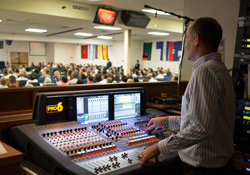
Remember that what the compressor does is to reduce the dynamic range of a variable signal, confining it into a smaller range. The ratio and threshold define the upper limit of this range, and the output compensation defines the lower end of this range. Without it you’re only half-done. Properly used compression should not be noticed.
A note about individual versus group processing: if there are not enough compressors for each vocal, you can use a stereo processor inserted in the vocal subgroup. However, there is a higher degree of freedom with implementing individual compressors. Group processing is recommended for a choir or background vocals.
Mixing Vocals
A lone singer in a band is usually rather easy to mix—make sure the lyrics can be heard intelligibly without overpowering the band. Toss in background vocals (BGV) in addition to the lead and the mix can easily get out of control.
The EQ approach for BGV is different than for lead vocals. You can be more aggressive with BGV EQ to keep feedback or bleed under control (increased amount of open mics) without affecting their overall appearance.
Pay special attention to the lead vocal mic. The lead vocal or worship leader has to be clearly distinguished without overpowering the others. The lyrics, as well as any spoken words during the performance, need to be heard clearly by the audience. The BGV and/or choir level must fit in the whole mix.
A little background in music theory: chords. When there’s a lead singer and a BGV group, it’s likely that the group is doing a two-voiced harmony. By adding the lead’s first voice (or melody), you now have a three-voiced chord for every note where the BGV sings. It’s like a piano where each finger playing a key represents a human voice. Fully defined chords are composed of at least three notes. Each note contributes to the quality of the chord (major, minor, seventh, ninth, augmented, suspended, etc.).
The melody is always the first voice (typically sopranos in choir setting). If one of these notes can’t be heard, then the intended quality of the chord is missed. Translating this into the mix, make sure that all voices are present. In live mixing, I’ve noticed that the BGV singing the first voice requires a little boost over the other vocals.
Unison—one note (same frequency)
Duo—two-voiced chord
Chords (fully qualified)—three, four-voiced (an up) chords
Modern voicing—makes some interesting alterations to the second and third voices (e.g., the third voice can be singing notes one octave up or down during the entire song or during some verses).
Constructing The Mix: Balance
A) Identify each voice’s voicing, especially the first voice or soprano. The harmony of each chord has to be heard (quality).
B) Pair equal voices (people singing exactly the same thing), try to make them sound like one (level wise).
C) Balance each group relative to other groups – consult the musical director or group leader to get feedback about the balance between the different voicings. Sometimes a background vocalist may sing the melody to support the lead singer.
D) The group with the first voice or sopranos should be a bit over the other groups (perceived level). If there is a leader or lead, then the leader has to be slightly on top. Compressors (properly used) are a huge help in placing the lead voice in the mix, and they also free you from having to “ride the faders” all the time. Another use for the compressors is that they help to maintain the harmony (i.e., the relative level between the different voicings). After the initial compressor setup, use the compressor output level and the faders to fine-tune the balance.
E) The perfect balance is reached when you can’t distinguish individual voices or singers (besides the leads). The entire choir or group sounds like one huge instrument or an organ.
